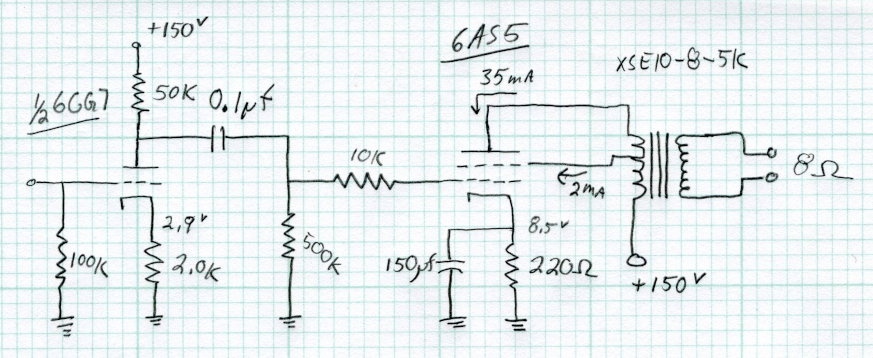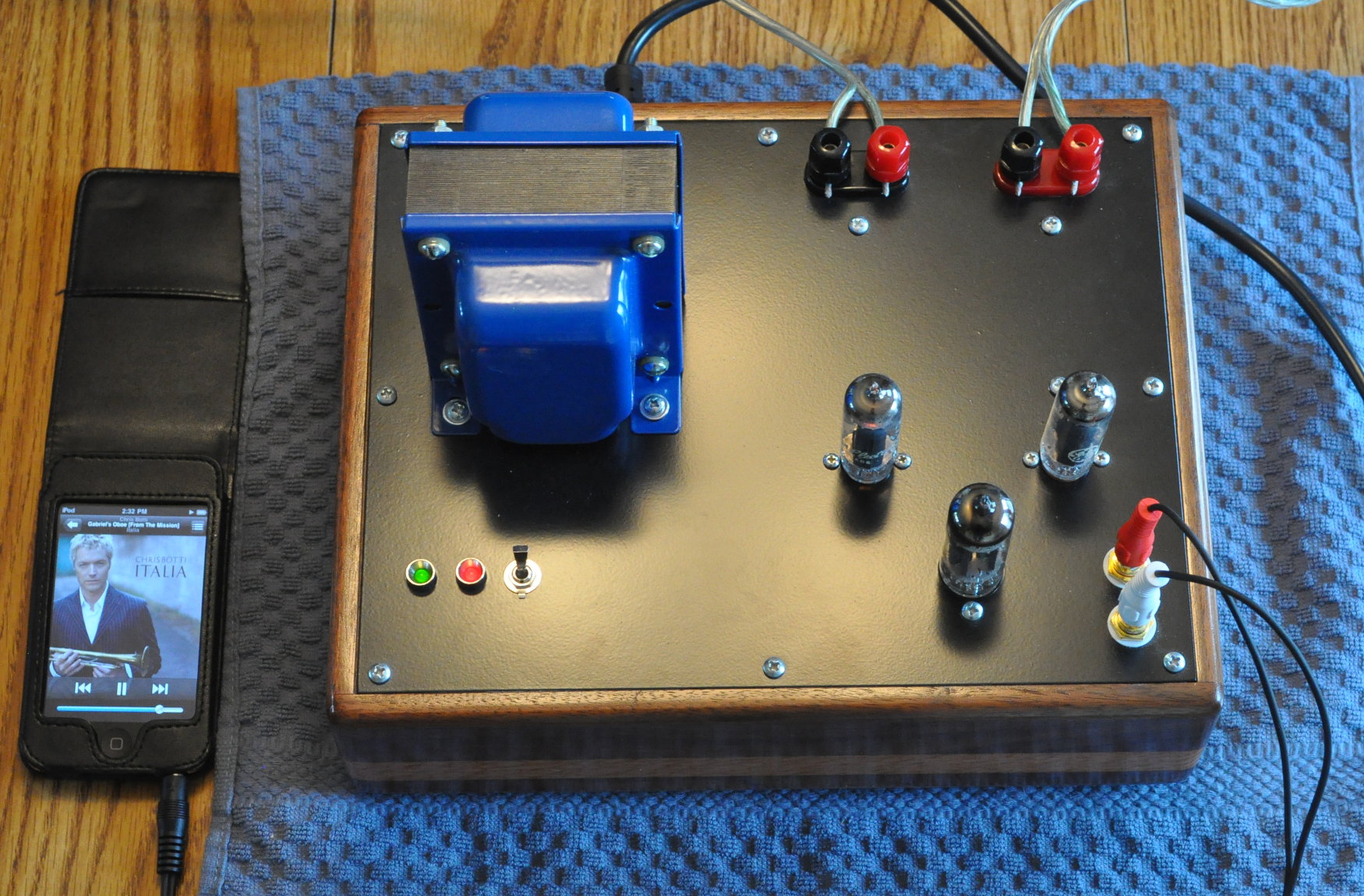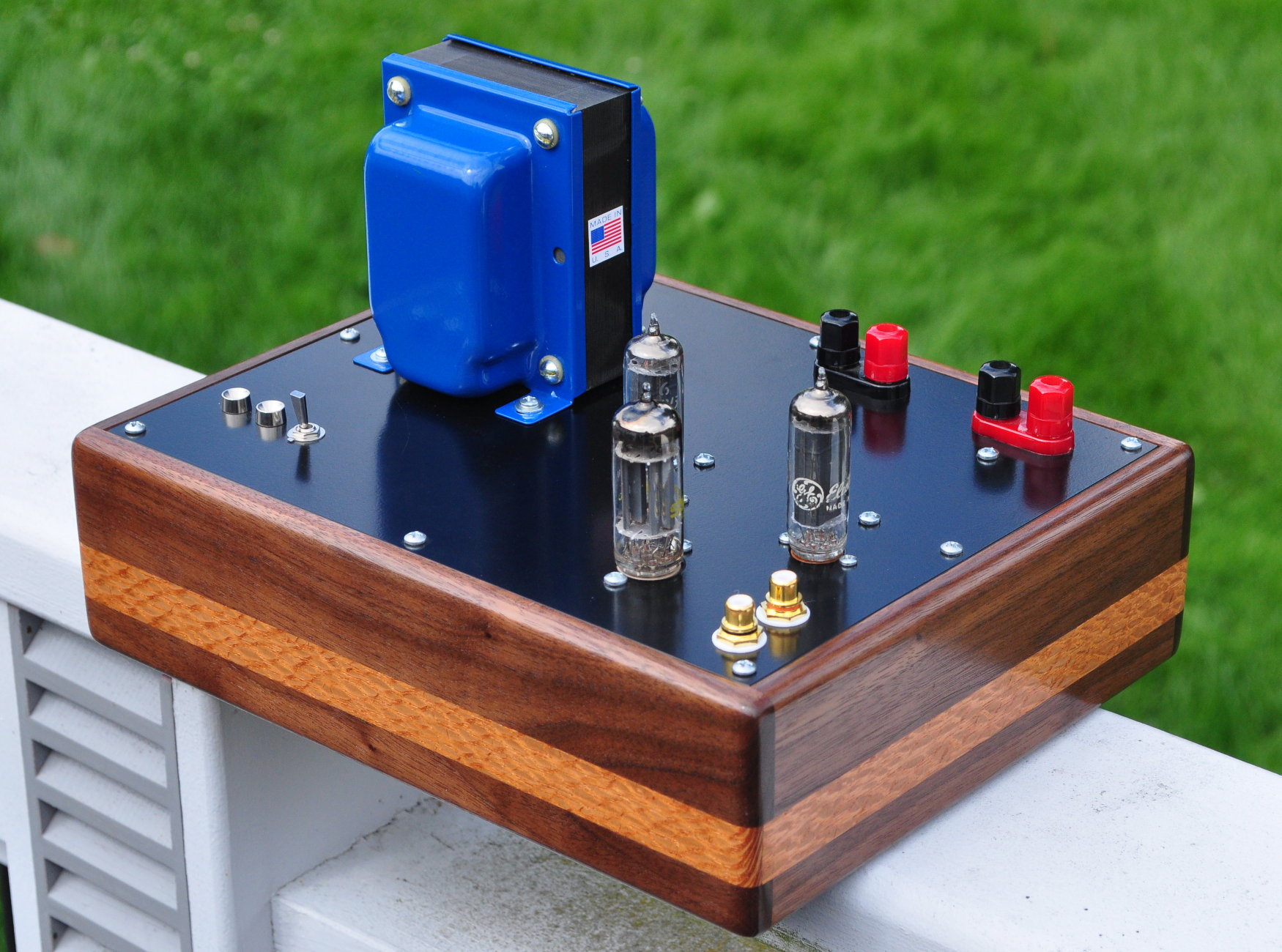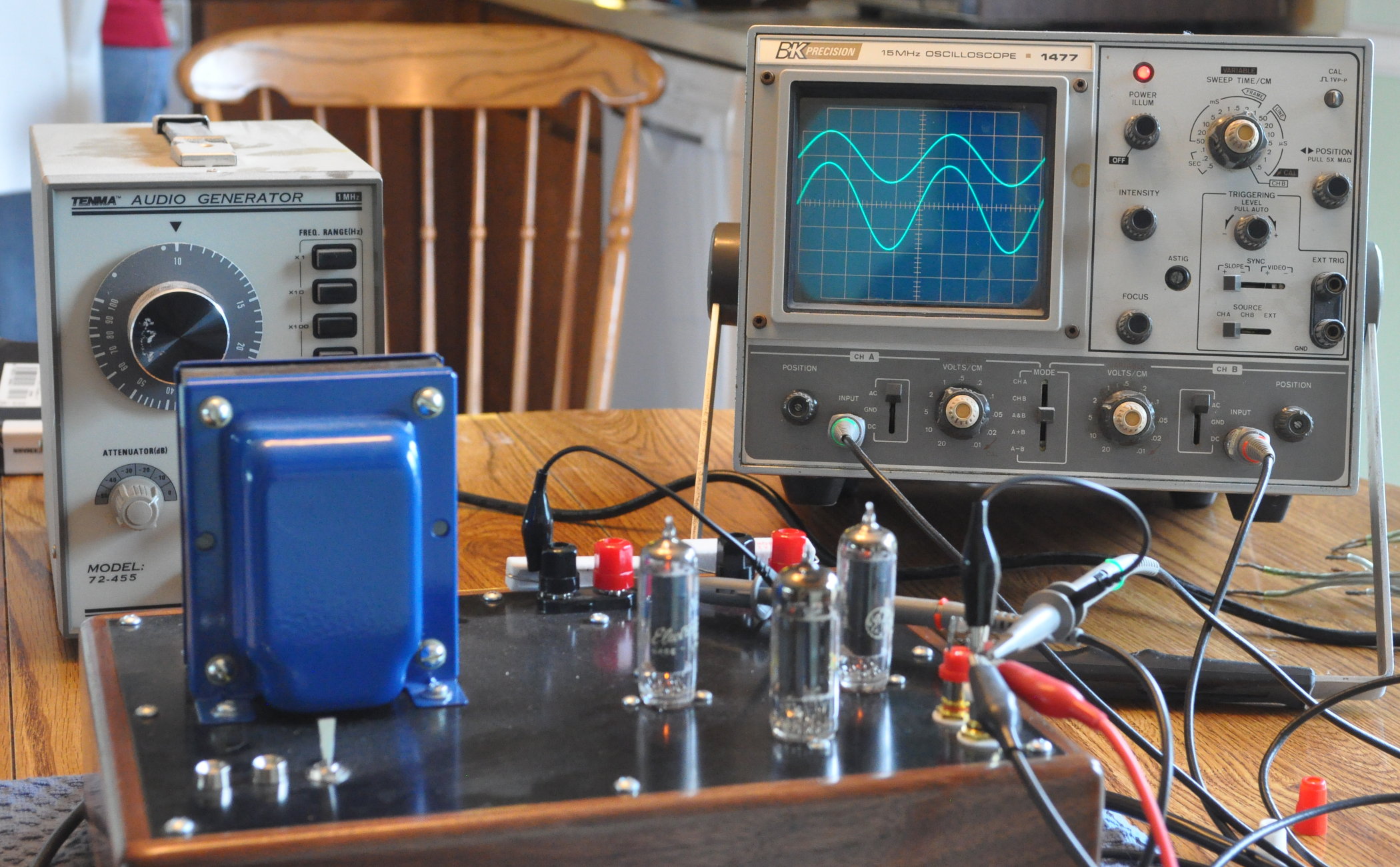A Micro-Power Powerhouse!
Here is a nice little amp that started out as an exercise in the inexpensive. The basis for this amp was a stack of 6AS5 power pentodes that I got for $2 each. This is a little power tube initially developed for automobile radios. As such, it’s not very powerful and runs off of fairly low B+ (150v max). Typical operation, at least on the data sheet, is 2.2w into the output transformer with 10% THD. I was determined to improve on this distortion performance even though I knew it would cost me some power. When ever possible I selected surplus components (or at least those I already had on hand).
The Electrical Design
The amp uses a very straight forward design. The small base 6AS5 tubes are self biased at about 8.5v and run in UL mode with about 150v on the transformer. The driver is a 6CG7/6FG7 (a small base version of 6SN7) with a 50kΩ plate load biased at a little under 3v. Here is the schematic.
 There is no volume control in this amp. It was concieved as a small amp to be driven by something like an iPod so the volume control would have been redundant. I also wanted not just good, but GREAT channel seperation on this amp. This meant seperate power supply filters for the power stages and the driver stage as well. Here is the power supply schematic.
There is no volume control in this amp. It was concieved as a small amp to be driven by something like an iPod so the volume control would have been redundant. I also wanted not just good, but GREAT channel seperation on this amp. This meant seperate power supply filters for the power stages and the driver stage as well. Here is the power supply schematic.
The Build
Now, looking at the two schematics and the picture of the amp, something quickly becomes apparent. This amp has a lot of stuff crammed in a very small chassis. Here is the way I handled the situation.
 In this photo. the power supply portion is on the right side of the chassis, and the audio portion is on the left. In the power supply section we have one 8H choke (in yellow), two large primary filter caps (these are the light blue ones running left-right), and three individual channel caps mounted on the partition (you really only see one with the other two underneath). The large items on the amp side are the two Edcor output transformers. The remainder of the components fit right in. Now because of all this iron, this amp is fairly heavy for it’s size. But the weight lends it a nice stability and solid feel when you pick it up. Overall I don’t mind at all.
In this photo. the power supply portion is on the right side of the chassis, and the audio portion is on the left. In the power supply section we have one 8H choke (in yellow), two large primary filter caps (these are the light blue ones running left-right), and three individual channel caps mounted on the partition (you really only see one with the other two underneath). The large items on the amp side are the two Edcor output transformers. The remainder of the components fit right in. Now because of all this iron, this amp is fairly heavy for it’s size. But the weight lends it a nice stability and solid feel when you pick it up. Overall I don’t mind at all.
Also note that due to the use of solid state rectification, I included a stand-by switch. The main power switch is on the back next to the fuse and power cord. When on, this lights the green LED on the top of the amp. The stand by switch is on top of the amp in front of the power transformer. When high power is supplied via this switch, the red LED lights. This allows me to let the tubes heat up prior to slapping the plates with high voltage and also gives a clear indication of the amp’s power state.
Here is a shot of the amp when under test.
It’s feeding resistive loads instead of speakers but you can see from the scope that the output is fairly clean. Shortly after I took this shot (everything checked out fine) I fired up the amp with it’s first real music. Here is the amp playing “Gabriel’s Oboe” from Chris Botti’s album “Italia”(driven quite nicely by an iPod Touch).
 The amp sounds really good in spite of it’s low total power output. Here sensitive speakers are a must; at least 90dB.
The amp sounds really good in spite of it’s low total power output. Here sensitive speakers are a must; at least 90dB.
The Results
The question here is about how to sum up this build. This amp has a very interesting look. The chassis is American dark walnut with an inlaid band of Australian Lacewood all toped with an oil finish.
 This makes for an eclectic look that I think comes together well. The amp sounds good. The highs are crisp and clear, mids are smooth, and the bass end is well balanced. Overall I would call this an excellent performer, especially in the light jazz and clasical arena.
This makes for an eclectic look that I think comes together well. The amp sounds good. The highs are crisp and clear, mids are smooth, and the bass end is well balanced. Overall I would call this an excellent performer, especially in the light jazz and clasical arena.




Got all that and thankyou for prompt and detailed reply. It will be interesting to compare this to the 6cy7 amp.
Hi, not sure how I overlooked this till now. Anyway I have the heavy bits already and I am about to order the resistors.
You normally use 1/2 watt metal film resistors and I’ll follow there except the 100 and 1,000 Ohm resistors in the final stage of the power supply. I thought 5w wirewound for these.
Any views on these welcome in case I’ve missed the point, again.
Mark
I generally use all 1/2W metal film resistors just like you said. The final 1kΩ and the 100Ω resistors in the power supply can be 1/2W as well. The 100Ω only dissipate about 0.14W and the 1kΩ dissipates about 9mW. The only place I might increase the power rating is the 220Ω resistors in the cathode of the power stages. Although these only dissipate about 300mW (and I used 1/2W metal film for these in my build) I might up them to 1W just to keep them cooler because they are generally very close to the bypass electrolytic capacitors which can be sensitive to heat.
Pingback: Revisiting Past Endeavors | Cascade Tubes
Hello there, I am very interested on your project in particular this one and also the 6CY7 amplifier, in your opinion witch one do you like more? Also in this project can you please let me know what kind of choke did you used? Is said 8H but nothing else….Regards
The 8H choke I used is actually a RDC-100 that used to be carried exclusively by Antique Electronics Supply. Unfortunately they are no longer available (See this post.). As a replacement I would recommend the Triad C-14X (C-14X (6H, 200mA)(Allied)) or one of the Hammond 159R (6H, 200mA), 159Q (7H, 150mA), or 159P (10H, 125mA) chokes from AES. All these chokes are essentially the same size and all will deliver very acceptable performance.
Is there any advantage in using the Edcor GXSE transformer over the XSE?
Absolutely! The GXSE will support lower frequency response than the XSE (40Hz vs 70Hz).
With the driver unbypassed and the 500kΩ grid resistor on the power stage, the 0.1µf coupling capacitor supports a low frequency roll off of about 3 Hz and the power stage has a natural rolloff lower than 5 Hz. This means that the limiting factor for low end frequency response is all in the output transformer.
Just keep in mind that there isn’t much output power here so the changes to the low end will be subtile unless your speakers are very efficient.
Hello there.
Awesome work. I have been perusing your site looking at all the fine examples of your crafty work. This unit has a killer case.
As someone who grew up in the 70’s and 80’s and has spent the last two decades servicing gear with solid state amplification I have only recently discovered the audio+visual magic of vacuum tube amplifiers and I am now hooked. I keep coming back to your site and the dyiaudio projects forum for inspiration. I can only aspire to one day be able to make my builds look this nice.
I appreciate the bits of technical information that you share with us here as well, you sure know your stuff. Thanks for that!
Ernesto.